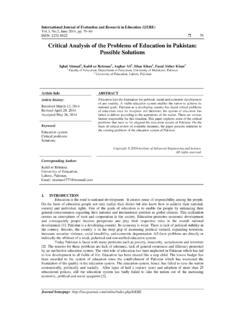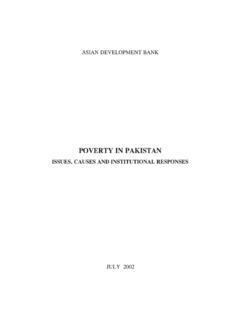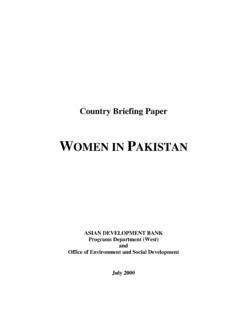Transcription of Labour and Employment Law - A Profile on Pakistan
1 Labour and Employment Law: A Profile on Pakistan Iftikhar Ahmad[1] Introduction Pakistan is the sixth most populated country in the world having a population of 167 Million, as estimated by the Population Census Organization. The estimated labor force is million ( participation rate). Labour force comprises all persons ten years of age and above, who fulfill the requirements for including among employed or unemployed. According to this concept, the employed labor force is million (unemployed million) and more than half of the population is concentrated in the rural areas.
2 Of the employed Labour force, women constitute only 20% (10 million). Agriculture sector employs 44% of the labor force, second to it is services sector (employing 35%); industry and manufacturing employ only 20% of the labor force. Formal sector accounts for only 27% of economic activity while informal sector is catering to more than 70% of the activity outside agriculture ( Labour Force Survey, GoP: 2007-08). Pre-Independence Era The Indian Subcontinent, of which Pakistan is only one part, was ruled over by British for nearly a period of 200 years (1757-1947).
3 It all started with trade, with coming in of a monopolist trader East India Company. The East India Company usurped and profited the resources of this region firstly by getting goods manufactured at lowest prices (mostly textile and spices) and then selling these in Europe and UK at higher prices and when textile industry was established in England in the wake of industrial revolution and British Crown took control of subcontinent, the market for these goods was closed for Indian competitors through stricter legislations (Amjad, 2001: 3-7). After the takeover, a series of industrial relations legislation was introduced, in the remaining part of 19th Century, which had the primary objective of providing England a protected and bonded labor market (Amjad, 2001: 10).
4 Two important industrial relations legislations of that era were Employers and Workmen Dispute Act, 1860 (making breach of contract by workers punishable, with no provision for employer breaches) and Indian Factories Act, 1881 (applicable to premises using mechanical power, employing 100 or more workers and it also prohibited Employment of children between 7 to 12 years of age for more than 9 hours a day). It has been argued that the factory legislation and disputes legislation were enacted only to protect the British industry from Indian competition and British investors interests in the area.
5 (Shaheed, 2007:67) After the First World War, labor unrest increased and there were repeated strikes at that time. The labor-management relations were given importance for the first time, earlier the common law principle of conspiracy applied to labor unions. The Indian Trade Union Act was passed in 1926 and after a span of three years, Trade Disputes Act, 1929 was also passed. The Trade Union Act allowed the workers to associate and to be represented by unions. The Trade Disputes Act provided for the prevention and settlement of disputes between employers and employees.
6 These disputes could be referred to a court of inquiry or board of conciliation (Amjad & Mahmood, 1982: 33). Much other legislation related to the labor welfare was introduced during this period. These include Factories Act 1934, Payment of Wages Act 1936, Mines Act 1923, Workmen Compensation Act 1923 and Dock Labor Act 1934. The Essential Services Maintenance Ordinance 1941 was promulgated in the wake of Second World War. The Industrial Disputes Act 1947 provided for permanent administrative machinery for settlement of disputes by specific procedures. The Act also provided for the constitution of work committees and referral, by the government, of a dispute to one man industrial tribunal constituted for that dispute (Amjad & Mahmood, 1982: 33).
7 It is important to mention that the aforementioned Act was the last piece of labor legislation before the partition of subcontinent and subsequent independence of Pakistan . Post independence Era (1947-69) After independence, Pakistan inherited the following legislations, among many others, from the British India: Trade Union Act 1926; Industrial Employment (Standing orders) Act 1946; Industrial Disputes Act 1947 and Factories Act 1934. These four laws provided the basis for labor laws and policy making in the country. These laws were quite forward looking and progressive in the sense that these allowed trade union activities in all the sectors except armed forces and police and the workers had the rights of collective bargaining and even strike.
8 Under the Trade Union Act 1926, the trade unions could also constitute a separate fund for promotion of civil and political interests of the members (Section 16) which meant that labor unions could use their funds in supporting some political party and in response gain support for pro-labor legislation in the parliament. The Trade Union (Amendment) Ordinance 1960, containing provisions of earlier Act, was promulgated in 1960 and it established the principle of compulsory recognition of trade unions by employers. It also reduced the number of outsider officers from 50 to 25 percent (Amjad, 2001: 72-76).
9 It also included the unfair labor practices, both on the part of Employers and Employees. The Industrial Disputes Act 1947 was replaced with Industrial Disputes Ordinance 1959 by a military ruler, Ayub Khan. The legislation withdrew the right of strike in an indirect manner. The workers could not go on a strike without giving due notice to the employer nor could they strike when the matter was pending before a conciliator or a court. The courts could also prohibit any (in progress) lockout or strike (Amjad & Mahmood, 1982: 34). The Industrial Disputes Ordinance 1959, in the Ayub regime, changed the system; more enterprises were included in the public utility definition and strikes were eventually banned.
10 The compulsory adjudication system made workers going from one court to another court for years in the quest for justice. During Yahya Khan Regime, the second military dictator, labor legislation was rewritten with emphasis on two points: the trade union movement should remain factory/plant based and delinked from the party politics. The martial law regimes, just after the first decade of independence, on the one hand did bring increased industrialization and jobs but on the other, also brought retrogressive labor laws and the system of repression, which still continues.









